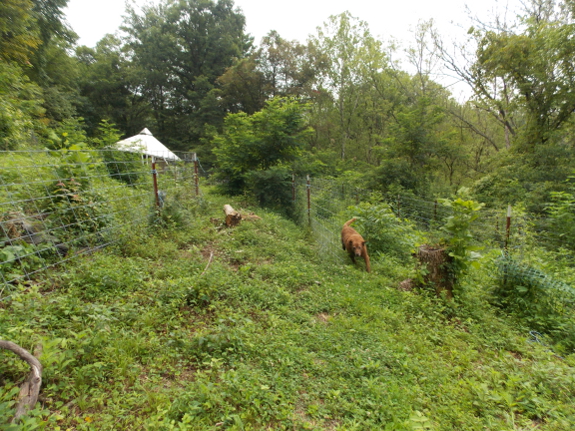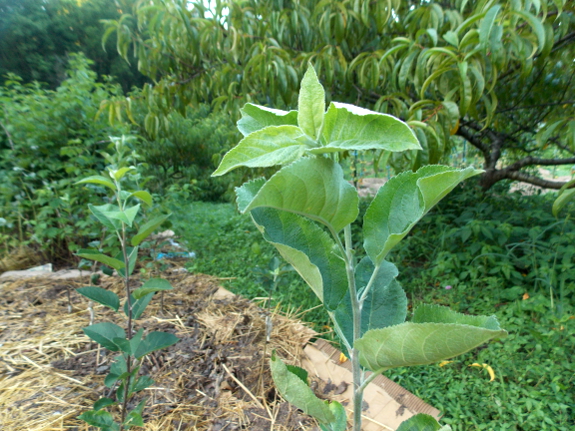
Keeping semi-dwarf apples small

I'd been planning on setting out our newly grafted apple trees into the tree alleys in the starplate pasture
this winter, but my gut says the soil there isn't ready to support tree
growth. Sure, the texture looked great when I dug into it last
winter --- well-drained and loose --- but plants have been slow to
colonize the bare soil. In our climate, all I should have to do is
avert my eyes if I want weeds to grow over my head, and instead, the
ground is still spottily covered with bits of grass and white clover
despite the copious addition of chicken manure from our pastured flock
and the last mowing over a month ago. As a result, I figure those
tree alleys need another year or two of TLC before I put beloved
perennials in place.

So...what am I to do with 11 beautiful apple trees? Even though a late frost kept our two-year-old high-density apples
from fruiting this year, I've been very happy with the vibrant growth
resulting from the training method. So I decided to keep this new
round of apples small and closer to home using similar high-density
methods. Sure, if I train the trees to stay diminutive, I'll
probably end up getting fewer apples from each plant, but I suspect I'll
get the same or more total apples since close-to-home trees are more
likely to survive and thrive.
Time to find gaps to
fill! I have five trees on M7 rootstock (usual spacing 12-15 feet)
and six trees on MM111 rootstock (usual spacing 15 to 20 feet) to play
with, so if I planted them traditionally, they would take up most of our
garden. However, the M7s should make good espaliers
along the front of the trailer and the MM111s can be trained to the
high-density method if I space them at least five feet apart (based on this handy calculator).
I'm curious to hear from folks who have played with espaliering --- do
you think a six-foot spacing for apples on M7 rootstock will work?
And, given that I'm most interested in productivity over beauty, which
shape would you recommend?
Want more in-depth information? Browse through our books.
Or explore more posts by date or by subject.
About us: Anna Hess and Mark Hamilton spent over a decade living self-sufficiently in the mountains of Virginia before moving north to start over from scratch in the foothills of Ohio. They've experimented with permaculture, no-till gardening, trailersteading, home-based microbusinesses and much more, writing about their adventures in both blogs and books.
Want to be notified when new comments are posted on this page? Click on the RSS button after you add a comment to subscribe to the comment feed, or simply check the box beside "email replies to me" while writing your comment.

I keep all of my fruit trees under 6 feet high, mostly using espalier forms. Probably one of the simplest and most productive espalier forms for apples is a simple fan shape. There a a fantastic book that describes a wide variety of training and pruning methods for all the different kinds of fruit: American Horticultural Society Pruning and Training, by Christopher Brickell and David Joyce
I'm growing my apple trees on semi-dwarf Geneva rootstock, because they are resistant to fireblight. One tip: varieties of trees that catalogs describe as "vigorous" are much more difficult to keep small. I'm regularly pruning 3-5 foot lengths of branches off of those each year - while my "non-vigorous" varieties are much easier to keep trained small. I absolutely love my mini fruit garden! Have fun!
I would recommend not putting them against the south face of a structure and have them free standing if possible. Our trees are along the south face of a fence (6-8" away)and it would only achieve enough sun light to produce if it had unobstructed sun the entire day. That is because we are far enough south that the sun goes above due east and west in the summer and the trees end up being in shade from that fence. June 21st the trees would only get 7 hours of sun if they were not shaded by any other object. If the trees were just a few feet away from the fence they would get much more sun.
As far as spacing we planned ours at 6 foot spacing and it is a bit cramped I'd try for 8 feet if you have the room.
The multi-tiered cordon method seems to be the easiest to maintain after the tiers are created. We have a candelabra type shape and the vertical arms are always trying to compete due to the apical dominance. I think the horizontal would help reduce that, but I don't know how difficult it would be to balance the tiers.
We did it to get a lot of varieties in a small space but they require more work than they are worth at least in our location (the shade for us means they are not productive.)
I hope they work out better for you.